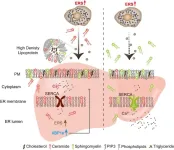(Press-News.org) The endoplasmic reticulum (ER) is the portion of the cell responsible for manufacturing and folding proteins. Proteins are essential for a wide range of cellular functions—as enzymes, transporters, hormones, antibodies, receptors, and more. They must be folded into the correct three-dimensional shape to function properly. If the ER is unable to manufacture or fold proteins correctly, the cell develops ER stress, which activates the unfolded protein response (UPR)—a protective mechanism aimed at restoring cellular function.
While UPR begins as an adaptive response, it can become maladaptive—ultimately causing cell death—if ER stress persists for too long.
Recently, a team of Chinese researchers led by Prof. WANG Likun from the Institute of Biophysics of the Chinese Academy of Sciences has provided new insights into metabolic disease mechanisms and potential therapeutic strategies by identifying a novel intercellular signaling mechanism between adipocytes (fat cells) and hepatocytes (liver cells). The study reveals how ER-stressed adipocytes remotely regulate UPR activation in hepatocytes through the secretion of ceramide (Cer), a fat molecule that plays a major role in cell structure, signaling, and stress response.
These findings were published in the Journal of Cell Biology on March 26.
In the study, the researchers first confirmed that ER-stressed adipocytes secrete bioactive signaling molecules capable of activating the UPR pathway in hepatocytes across tissues. Using lipidomics analysis and functional validation, they identified Cer as the key effector molecule responsible for this process.
Further investigation revealed that the UPR pathway in adipocytes does not directly regulate Cer secretion. Instead, ER stress promotes the extracellular hydrolysis of sphingomyelin (SM)—a type of lipid—into Cer through the secretion of acid sphingomyelinase (ASM), highlighting an indirect regulatory pathway.
By investigating how lipid-soluble Cer is transported between cells, the researchers demonstrated that high-density lipoprotein (HDL) serves as the primary carrier for Cer transport. Upon reaching hepatocytes, Cer alters membrane fluidity, influencing membrane protein function, and contributing to UPR activation.
Notably, the researchers also found that exogenous supplementation of SM effectively reversed the Cer-induced changes in membrane fluidity and UPR activation—underscoring the critical role of lipid metabolic balance in cellular homeostasis. The ability to suppress UPR activation suggests that maladaptive responses to ER stress may be reversible.
Expanding on these findings, the researchers discovered that this Cer-based intercellular UPR signaling mechanism has broader applicability, offering a new theoretical framework for understanding multi-tissue coordinated stress responses.
By systematically mapping the molecular pathway of UPR signal transmission between adipose and liver tissues, this study reveals a previously unrecognized form of organ crosstalk in metabolic diseases. These discoveries pave the way for lipid metabolism-targeted therapeutic strategies aimed at restoring cellular balance and mitigating metabolic disorders.
END
Adipocyte-hepatocyte signaling mechanism uncovered in endoplasmic reticulum stress response
2025-04-02
ELSE PRESS RELEASES FROM THIS DATE:
Mammals were adapting from life in the trees to living on the ground before dinosaur-killing asteroid
2025-04-02
More mammals were living on the ground several million years before the mass extinction event that wiped out the dinosaurs, new research led by the University of Bristol has revealed.
The study, published today in the journal Palaeontology, provides fresh evidence that many mammals were already shifting toward a more ground-based lifestyle leading up to the asteroid’s impact.
By analysing small-fossilised bone fragments, specifically end of limb bones, from marsupial and placental mammals found in Western North America - the only place with a well-preserved terrestrial fossil record from this time – the team discovered signs that ...
Low LDL cholesterol levels linked to reduced risk of dementia
2025-04-01
People with low levels of low-density lipoprotein cholesterol (LDL-C) in their blood have a lower risk of dementia, including lower risk of Alzheimer’s disease related dementia, shows a study published online today in the Journal of Neurology Neurosurgery & Psychiatry.
Use of statins conveyed an additional protective effect for people with low LDL-C, specifically those with blood levels less than 1.8 mmol/L (<70 mg/dL), reducing their risk of dementia even further.
However, reducing LDL-C ...
Thickening of the eye’s retina associated with greater risk and severity of postoperative delirium in older patients
2025-04-01
Thickening of the macular layer of the eye’s retina is associated with a greater risk of postoperative delirium for older patients undergoing surgery under general anaesthetic, reveals a study published online in the open access journal General Psychiatry.
Postoperative delirium is one of the most common complications for older patients after surgery and can have profound implications for long-term health and wellbeing.
Patients with postoperative delirium require longer hospital stays and are more likely to require support at home to help with daily tasks such as washing, dressing, and eating or be discharged ...
Almost one in ten people surveyed report having been harmed by the NHS in the last three years
2025-04-01
Almost one in ten people in Great Britain experienced healthcare-related harm due to care or treatment they received from the National Health Service (NHS) or difficulties accessing care in the last three years, show the findings of a large population survey published in the journal BMJ Quality & Safety.
In more than eight out of ten cases, the harm had a moderate or severe impact on the respondent. Disadvantaged groups, including people with disabilities, long term conditions and those in lower socioeconomic groups, were ...
Enhancing light control with complex frequency excitations
2025-04-01
NEW YORK, April 1, 2025 — Researchers at the Advanced Science Research Center at the CUNY Graduate Center (CUNY ASRC) and at Florida International University report in the journal Science their insights on the emerging field of complex frequencies excitations, a recently introduced scheme to control light, sound and other wave phenomena beyond conventional limits. Based on this approach, they outline opportunities that advance fundamental understanding of wave-matter interactions and usher wave-based technologies into a new era.
In conventional light wave- and sound wave- based systems such as wireless cell phone technologies, microscopes, speakers ...
New research finds novel drug target for acute myeloid leukemia, bringing hope for cancer patients
2025-04-01
A team of scientists from The University of Texas Health Science Center at San Antonio (UT Health San Antonio) has identified a promising new drug target for acute myeloid leukemia (AML), a deadly blood cancer with a five-year survival rate of just 30%, according to the National Cancer Institute. Their study, published in Cell Stem Cell in February, highlights the crucial role of a protein called paraspeckle component 1 (PSPC1) in the progression of AML.
An aggressive blood cancer, AML originates ...
New insight into factors associated with a common disease among dogs and humans
2025-04-01
The pathogens Giardia duodenalis and Cryptosporidium are common causes of sometimes-fatal intestinal diseases in humans, other mammals and birds worldwide.
Now, findings from researchers at Texas A&M University provide new, evidence-based insight into minimizing the risk of these diseases at canine facilities.
“In adult, healthy humans and animals, these diseases usually cause diarrhea and occasionally other minor ailments, but for infants, puppies and the immunocompromised, infection could be deadly,” said Loni Taylor, PhD, DVM, an epidemiologist with the Texas A&M University School of Public Health, who led ...
Illuminating single atoms for sustainable propylene production
2025-04-01
More than 150 million metric tons of propylene are produced annually, making it one of the most widespread chemicals used in the chemical industry.
Propylene is the basis for polypropylene, a polymer used in everything from medical devices to packaging to household goods. But most propylene is produced through steam cracking, a high-energy process that uses heat to break down crude oil into smaller hydrocarbons.
Now, Northwestern University chemists have found a way to create propylene using light. Their findings show that a nanoengineered photoactive ...
New study finds Rocky Mountain snow contamination
2025-04-01
Mountain snowpacks accumulate snow throughout the winter, building up stores of water that will supply communities across the American West throughout the long dry season. Now, a new study shows that as storms carry snow to the Rocky Mountains, they are also bringing mercury and other contaminants from mines in the region. The research helps scientists understand how contaminants are spread by atmospheric circulation and has implications for snowpack preservation and illuminating the lasting environmental impact of mining activities.
The study, published in the May issue of the journal Environmental Pollution, examined contamination levels for ...
Study examines lactation in critically ill patients
2025-04-01
It can happen in an instant – a mother experiences a medical emergency during delivery that requires intensive care.
Meanwhile, her newborn infant is sent to the neonatal intensive care unit.
This early separation can greatly disrupt the establishment of adequate milk supply for those who want to breastfeed.
Recent research from the University of Michigan reveals that simple awareness on the part of the care team can help protect the breastfeeding relationship for patients in the ICU.
The work was spearheaded by Kayla Kolbe, M.D., clinical assistant ...


